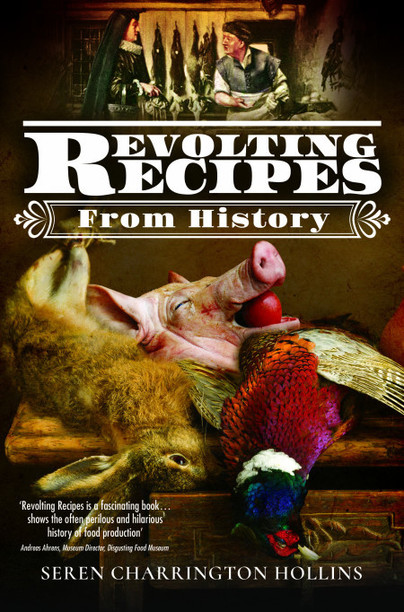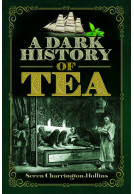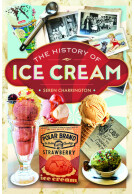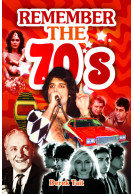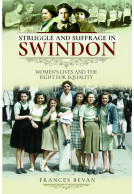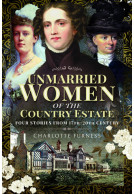Revolting Recipes From History (Hardback)
Imprint: Pen & Sword History
Pages: 208
Illustrations: 50 black and white illustrations
ISBN: 9781526773029
Published: 6th May 2022
(click here for international delivery rates)
Order within the next 7 hours, 22 minutes to get your order processed the next working day!
Need a currency converter? Check XE.com for live rates
| Other formats available - Buy the Hardback and get the eBook for £1.99! | Price |
|---|---|
| Revolting Recipes From History eBook (41.3 MB) Add to Basket | £6.99 |
Nothing causes a stir on social media platforms like a topical discussion on the latest food trend. Modern-day chefs like to think that they are creative and often claim to push boundaries of food creation, but if we want to explore real culinary creativity then we need to look to our ancestors.
Writer and food historian, Seren Charrington-Hollins delves into the history of culinary experimentation to bring us some of the weirdest and most stomach-churning food delicacies to ever grace a dining table. She uncovers the rather gruesome history behind some everyday staples, uncovers bizarre and curious recipes, whilst casting a light on foods that have fallen from culinary grace, such as cows udders and tripe; showing that revulsion is just a matter of taste, times and perhaps knowledge.
From pickled brains to headcheese, through to song birds and nymph's thighs, this book explores foods that have evoked disgust and delight in diners depending on culinary perspective.
So pull up a chair, unfold your napkin and get ready for a highly entertaining and enlightening journey to explore what makes a recipe revolting? Be warned; you’ll need a strong stomach and an open mind.
Rating: 5 out of 5 stars
NetGalley, June Lee
Have you ever wondered how culinary trends evolve—or devolve? Seren Charrington-Hollins' "Revolting Recipes From History" is an entertaining, eye-opening, and occasionally stomach-churning exploration of foods that have graced historical tables. From pickled brains to canned catastrophes, the book offers an unflinching look at humanity's bizarre, bold, and sometimes baffling culinary choices.
This is not a cookbook—though it does include a few historical recipes that might tempt only the most adventurous (or foolhardy) of chefs. Instead, it’s a historical deep dive into the foods that past generations ate with gusto, often leaving modern readers cringing in disbelief. The book uncovers the fascinating stories behind dishes like cow udders, frogs, insects, and blood-based concoctions, challenging modern sensibilities while showcasing the ingenuity—and occasional recklessness—of our ancestors.
So, if you’re looking for a humorous and informative journey through the weird and wonderful world of historical gastronomy, pull up a chair, pour yourself something strong, and dig in. Just don’t read it over dinner.
A good introduction to food history.
Everything is Better with Dragons
Read the full review here
Those of us who love food and consider ourselves foodies, will enjoy reading the essays and learning everything we can about food from the past. We will be very thankful that we don’t have to eat any of the dishes described in the essays. It’s fun, though, to learn so much (the one with the most knowledge wins, of course). If you are interested in food, you’ll want to pick up this interesting history book.
NetGalley, Karen Hancock
Love the cover!
NetGalley, The Sassy Bookworm
I found this one to be super fascinating, humorous, and honestly, a bit gross, I love food. I love history, and Revolting Recipes From History gave me both in spades. Definitely worth the read. Two thumbs up!
What a great read for lovers of history, cooking, food. I find it amazing what people find edible or, especially, fashionable. Tiny songbirds? Just because you can? Birds baked into pies? Beware to be nauseated by some finds, but to laugh at others. An all-round, worth a sitdown read.
NetGalley, Jude Morris
Probably not a book to read before your evening meal or if like me you could easily become a vegetarian. Split into ten chapters, this book covers the lot in various chapters meat, fish, veg, animals long out of fashion and even whatever you can find in your garden. You name it someone’s tried to eat it including swans, owls, turtles, wasps, mice and the list can go on, if you could stick it in your mouth it very much seems someone has tried to turn it into a meal or certainly tried cooking it.
The History Fella
Although quite a bit of this book has turned my stomach it seems in many ways. I have really enjoyed reading it, after all it’s always fascinating to see how other people live or used to live and looking at how people ate is an important thing and goes to show how much somethings were in abundance but no longer are. A huge amount of research must have gone into this book and credit to the author who has written a fascinating book.
What this book has bought back to me is to be thankful for present day food hygiene standards, when you see the conditions of some of the meat hanging outside shops next to a busy road. It would seem that people in history must have had strong stomachs and to be honest what this book has done has bought back my memories of eating things I would rather forget about like haggis, liver and squid. I would greatly recommend this book to others who want an off the wall read of a great book.
Read the full review here
Rating: 5 out of 5 stars
NetGalley, Esther Quintanilla
I found this book to be well researched and recommend to anyone who enjoys history, especially the history of food. Although I don't suggest you read this book if you're on the queasy side. With that being said, I devoured this book and all it's oddities. Two thumbs up.
Rating: 5 out of 5 stars
NetGalley, Sandra van der Plaats
This rather daring read is certainly not for the faint-hearted, but I devoured this book from the first page.
I have always been fascinated by culinary history, and have alway enjoyed watching series about culinary history, such as ‘A House Through Time’ (BBC) and ‘Food Through the Ages’ (BBC, with Sue Perkins and Giles Coren) immensely, so that is why I picked up this book.
Nowadays, we simply open the fridge and grab whatever is available to make a quick sandwich or an easy dinner; however, things were really different in the past.
I am not at all afraid to eat strange things, and can boast of having eaten fried crickets, grasshoppers, crocodile, kangaroo, snake, frogs, and much more; I love my black pudding (pig’s blood with oatmeal) and haggis (sheep liver, heart and lungs), so I guess you could call me an adventurous eater, there are very few things that I won’t eat…
This book tells a fascinating story about the culinary things that used to be standard cuisine, such as faggots, drippings, brains, tripe, chitterlings (washed intestines that have been prepared and cooked), and cow’s heel, in a world in which butchers proudly displayed their wares.
Food, and what we eat, turns out to be a cultural thing, - and some things can or cannot be eaten due to religious food rules. From Medieval times to the Victorian Age food was more or less preserved in the same way, but the way we eat, and shopped changed drastically when food was stored in tins, albeit not yet appreciated during that time.
The book further elaborates on the many food scandals surrounding tinned foods.
Meat has always been reserved for the rich, yet poor Victorians were forced to eat offals, like slink (prematurely born calf), broxy (diseased sheep) or tainted meat.
Some recipes have been added from Mrs Beeton’s Book of Household Management (1861), so for readers who’d love to try to eat something different for tonight’s dinner, this is a wonderful book to start with. It contains a number of recipes, but other than that, it is mainly about a lot of fun facts about how our diet has changed since times past. A culinary historical book about what people had for dinner, interspersed with funny facts, I loved it!! For lovers of culinary history a must-read!!
Fascinating, gruesome and seriously compelling. This book combines a number of elements which are all of deep interest to me, food, science, history and gross to amazing effect. The book is absolutely packed full of amazing detail and covers a vast reach of history and array of odd eating habits, or rather odd to us as the modern reader, I guess whatever is your normal is normal right? The anecdotes and food poisoning disasters are fascinating and cautionary tales and the resilience of humans in hard times to make use of all food parts is humbling and impressive. Glad to say it hasn’t put me off and I’m actually intrigued enough to (maybe) try some of the (tamer) oddities, maybe tripe might be on my bucket list as I feel I might be missing out. Wish me luck and enjoy this book, heartily recommended.
NetGalley, Helen Frost
Revolting Recipes From History by Seren Charrington-Hollins is a delightful trip through the less delightful side of food history. From dangerous to disgusting, it is covered here.
NetGalley, Jack Messer
First, no, this is not full of recipes, and I have no problem with that. I have no intention of trying any of the ones that are included and I prefer to read about the ingredients that my contemporary mind finds disgusting rather than see a recipe that illustrates how that item was used. The description of a dish is sufficient for the purpose of this book.
A fair part of the book discusses canning, which might at first seem off topic. But some of the examples of what was canned and how they were used was, wait for it, revolting. To know that military members almost received canned goods that were disgusting and putrid qualifies, as far as I'm concerned, for revolting food. It actually highlights how we can sometimes forget that ways of preserving food have their limitations. My personal mistakes usually fall into thinking that because I froze something it will be good when I decide to use it. Well, there is such a thing as too long.
I would recommend this to readers who enjoy looking back at how things were and how things are. I know that when teaching medieval history courses my students were always fascinated by the culinary differences and on several occasions we had a potluck with medieval dishes (though the ingredients were fresh). Food historians will enjoy this as well even if there is not much new in it for them, sometimes looking at a topic as a whole is refreshing.
Rating: 5 out of 5 stars
NetGalley, Elizabeth McLaughlin
Food is a topic almost everyone can get behind, unless you're eating delicacies from this book!
Revolting Recipes From History covers the history of food items that were once (or still are) considered delicacies in parts of the world that are no longer considered widely palatable. The book is well-researched and well-written; I found it disgustingly delightful.
I'd highly recommend this book to anyone who likes history, food, or getting a look into how the sausage gets made.
Rating: 5 out of 5 stars
NetGalley, Annie Buchanan
Revolting Recipes From History is a humorous, honest, and well curated choice of culinary oddities, weird combinations, and potentially dangerous historical foods by food historian Seren Charrington-Hollins. Due out 30th April 2022 from Pen & Sword, it's 216 pages and will be available in hardcover format.
The author does a very good job of exploring the real cultural and biological background behind some people's visceral reaction to different widely divergent foodstuffs. Why do we react with revulsion when faced with fermented shark and/or lye treated - saponified whitefish when people in some places consider them a delicacy? It should be noted that the book does not contain actual recipes (and most of the subjects are for things I can't imagine actually eating; certainly not willingly).
Although admittedly a niche book, it's well annotated throughout and the author writes knowledgeably on the subject, The bibliography is comprehensive and will provide many hours of further reading and information. The book is largely without illustrations, but there are a number of facsimile adverts and period photographs and documents contained at the back. I especially enjoyed seeing the period ads for frog farming (for fun & profit), and the very early tinned and preserved foods.
As a historical insight, I found it fascinating and devoured it (haha) cover to cover. This was well worth the read, and for recreators and SCAdians (and the like) this would make really great source material.
Five stars. Weirdly fascinating.
Rating: 5 out of 5 stars
NetGalley, Katy Shawcross
A fascinating look into the gruesome side of culinary history. The author takes us through centuries of food preparation and preservation. We explore our relationship with offal, seafood, and how these foods have changed throughout history, including a very detailed look at how the canned food industry has had more than a few tribulations. Thoroughly enjoyable, and highly recommended.
Rating: 5 out of 5 stars
NetGalley, Cindy R
This fantastic book explores food in a way I have not seen before. I have learned a lot from these pages. While it is true that there are a lot of gross, gruesome, food and the recipes, in here, There is a ton of learning.
For example, do you know when canning was invented? Did you know that carrier pigeons were a popular dish?
Did you know that your ancestors very possibly dined on things like rat? Or cat? Or dog? How about sheep uterus?
Do you enjoy Stilton cheese? Foie gras ? You really need to read this book. It is fascinating and revolting and thoroughly wonderful.
Warning, I do not recommend reading while eating.
Thank you to NetGalley and the publisher for allowing me access to this ARC, enjoyed every single minute of this one.
Rating: 5 out of 5 stars
NetGalley, Brenda Carleton
riveting book, the author describes what causes our revolting responses such as culture, physiology, religion practices and protection from unsafe foods. Some cultures and roadkill folks relish decay and their bacterial benefits. Others prize foods writhing with maggots and yet others splash their culinary forays on social media. Sometimes the genuine article such as turtle is prepared with imposters (calf head) due to restrictions. It is important to remember what we may find hideous may be a delicacy elsewhere for important cultural/traditional/environmental reasons such as during war.
The author describes the body parts (and bodies) eaten and when and where recipes and experiences were first recorded throughout history. Not only that but she includes recipes for dishes such as Elder seasoned with salt and vinegar, Calves' Brain Cakes, Cow Heels and Nymphs' Thighs (these are amongst the mild recipes) and preparation techniques including putrefaction, pickling, boiling, drying, moulding and salting. She discusses scandals, animal welfare, food quality and spoilage, colourants, the allowable amount of insect parts in foods and health concerns (also death, including murder) as well as human blood plasma use. Another intriguing topic is called Debauched Dining which is vulgar opulent dining to the extreme, aka Caligula. But this is just the beginning!
People who enjoy culinary history and learning about cultures through food, do add this to your to be read pile. Descriptions are grotesque and disturbing at times therefore not for everyone. For readers with adventurous palates like me who are smitten with food curiosities and history, there is much to chew on and remember. Books with food descriptions endear me immediately! My Larousse Gastronomique is one of my treasured possessions.
My sincere thank you to Pen & Sword and NetGalley for the privilege of reading this brilliantly compelling book!
Rating: 5 out of 5 stars
NetGalley, Hazel Thomson
I thought this would be an ok book, but I was wrong. Its AMAZING!! What a fascinating although at times stomach churning read!!!
Its well-researched and written. Looking at all sorts of different foods and meals over the centuries.
I think one of the reasons I enjoyed it so much was that I was sharing in my disgust with my teenage son and then went out to my very elderly Grandmothers and said about it and she remembered during the war eating some of the culinary delights!! She worked in a butchers and recalls cleaning the tripe!!! So the book really does have something for everyone.
Rating: 5 out of 5 stars
NetGalley, Karen Bull
Interesting book
Very well worth reading
Well written and fascinating
Definitely worth reading
I loved this look at the ways in which food preparation, storage, and cooking was presented. Where would we be without the ingenuity creations of the past? A curious subject after that was highly entertaining.
NetGalley, Maggie Palner
Rating: 5 out of 5 stars
NetGalley, Karen Hammond
I started reading this the day I got it and just kept reading till I had finished. I didn't expect that ! I only stopped reading to tell the hubby some of the more gross sections in the book. Horrible Histories for adults is the nearest I can get. The downside ...I will be very wary about eating anything especially if it comes in a tin. The other stuff I can avoid but the canned goods scare me now,...... Did not expect this to be so entertaining or scary. Will buy this for my foodie friends, that will stop them preaching on about exotic foods.
Rating: 5 out of 5 stars
NetGalley, Kara Race-Moore
Writer and food historian, Seren Charrington-Hollins examines the history of food through the lens of dishes people would refuse today.
It shows how plentiful our current food supply is, in that we can turn up our noses at some of the parts of animal, or insist on only fresh fruits and vegetables in deep winter, rather than eating them after being pickled and brined.
An interesting look at the history both of what we eat now and what we longer eat, showing that what we now take for granted is not how it always was.
This book was delightfully revolting! The author did a great job describing many dishes from around the world. She also made interesting points like how butchers used to display the carcasses in their windows but now diners want to dissociate what they're eating from an animal and want the meat packaged cleanly and in little clear packages.
NetGalley, Jenessa Marshall
Some of the most disgusting dishes were baby toes brawn and roast hedgehog (though cleverly cooked using clay to remove the spines).
A great cache of historical recipes and facts, but not for the faint or heart or weak of stomach. I would have loved pictures of these finished revolting dishes as well.
I was fascinated by the different items showcased, particularly sea gull eggs and badger, and the history behind their use.
NetGalley, Maria Doktor
This book goes through food that today we might find gross but historically was very popular. It was really interesting to see what used to be considered delicious and often why it fell out of favor.
NetGalley, Christine Piepmeier
'Revolting Recipes is a fascinating book, well researched and very detailed. The book shows the often perilous and hilarious history of food production. Seren explores everything from the origins of tinning and blood consumption to insects as food and extinction by gluttony. You will learn about the deadly mistakes made in early meat conservation and how it gave rise to the tinned food we are familiar with today. The author explores the move to deboned, prepackaged meats far removed from the animals they came from, and how that makes us less likely to eat intestines and cuts of meat like cheek and tongue. Throughout the factual information, is recipes of some of the dishes, such as head cheese, penis stew, boiled tongue, and cows udders. Despite my experience in disgusting food, I learned a lot of new things from this book.'
Andreas Ahrens, Museum Director, Disgusting Food Museum.
About Seren Charrington-Hollins
Seren Charrington-Hollins is a professional food historian who is passionate about recreating dishes from the past and uncovering the history behind the foods that our ancestors enjoyed.
Living in Wales with her husband and young family, Seren is an avid historic researcher and her food history work has been showcased in country houses, museums and castles across Britain and she has made numerous appearances on national television and on global radio.







